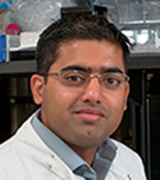Rithwik Ramachandran
 |
Associate Professor BSc St. Albert’s College, Mahatma Gandhi University, Zoology Office: Medical Science Building 266 |
Why Science?
Biology and English were my favourite subjects in school, and I followed the interest in biology and studied zoology for my undergraduate degree. This was a very broad program and for a time I considered studying ecology or marine biology but ultimately decided to study molecular biology and biotechnology for my Master’s. The Master’s degree covered a lot of different areas including the science of brewing beer and the use of microorganisms as factories for mass producing bioactive molecules. This program also sparked my interest in drug discovery and the study of novel drug targets. For my doctoral work I studied how cell surface receptors regulate inflammatory responses in primary human airway fibroblasts. This further solidified my interest in receptor pharmacology which is the broad scientific area that I still work in. After I finished my PhD, I had the opportunity to come to Canada and pursue post-doctoral training in molecular pharmacology. After that I was recruited to the University of Western Ontario in the Department of Physiology and Pharmacology to start an independent research program. The opportunity to continue the scientific research that I am passionate about and make new discoveries makes this a dream job for me. I also love working with the outstanding group of trainees in my research laboratory and seeing them grow and develop as scientists is most gratifying. Throughout my education, I kept an open mind and explored various fields. I have learnt that seemingly unrelated things that you study, or experience, can one day provide the insight required to understand whatever scientific problem you might be currently working on.
Research Goals
My lab currently studies the molecular pharmacology of G-protein coupled receptors (GPCRs), and Transient Receptor Potential (TRP) ion channels. GPCRs are crucial in the human body, as 40 – 50% of drugs target them. Specifically, I work with PARs, a four-member family of GPCRs that are involved in our response to injury and inflammation. PARs are highly expressed in platelets and are also involved in triggering pro-inflammatory response in various settings. We also study a larger family of understudied GPCRs called adhesion-GPCRs that are important regulators of a variety of physiological and pathophysiological conditions. I am also very interested in TRP ion channels which allow us to sense various physical (e.g., temperature, mechanical forces) and chemical stimuli (e.g., capsaicin, menthol, mustard oil) and have been proposed as new drug targets for inflammation and inflammatory pain.
My lab uses various techniques including high resolution microscopy, resonance energy transfer assays, calcium signaling and imaging, platelet signaling assays, vascular tissue assays, and animal models of disease to understand cell-signaling responses to GPCRs and TRP channel activation at the molecular level and in vivo. These studies have relevance to various human diseases including cancer, fibrosis, cardiovascular diseases, and inflammatory diseases such as colitis and osteoarthritis.
Specific Research Interests
- Understanding Receptor signaling at the molecular Level and discovery of novel therapeutics.
My research focuses on understanding the molecular mechanism that enable activation of various receptor signaling pathways, including how specific amino acid residues in the receptor enable interaction with different signaling partners or affect receptor-drug interactions. Furthermore, we focus on finding ways to use the information gathered on receptor interacting sites to find new strategies to activate or disrupt signaling pathways. For instance, we identified a region of the human platelet thrombin receptor (PAR4) that was important for interactions with two signaling molecules (Gq/11 and beta-arrestin). We were then able to design a lipidated-peptide that was able to disrupt this interaction and prevent platelet aggregation in a mouse model of thrombosis.
- Understanding GPCR and ion channel function in pathophysiology.
Several receptors and Ion channels being studied in our lab are implicated in diseases, particularly cardiovascular diseases (e.g., athero-thombosis, stroke), inflammatory (e.g., osteoarthritis, colitis, neuro-inflammation) and malignant diseases (prostate and hepatocellular cancer). As such we use human patient derived samples and various small animal models of disease to test novel interventions as therapeutic strategies. We routinely use transgenic animals, CRISPR/Cas9 genomic editing strategies and pharmacological tools for these studies. For instance, we recently developed a set of genetically encoded biosensors that detect the expression of certain disease-causing molecules in the knee joints of osteoarthritis patients. We are now trying to specifically target the molecules to reduce pain and inflammation in this disease.
Most Rewarding Moments
Making new discoveries and finding out something that no one else has figured out is very exhilarating and this is indeed one of the most satisfying aspects of my career as a scientist. Another very rewarding aspect of my work is the opportunity to work with trainees and see them develop and grow as scientists. I am also a big proponent of teamwork and collaboration. The opportunity to interact and work with brilliant scientists in Canada and across the world is also immensely rewarding.
Awards and Recognitions
Publications:
See my publications on Pubmed:
See my publications on google scholar:
Highlighted Publications:








